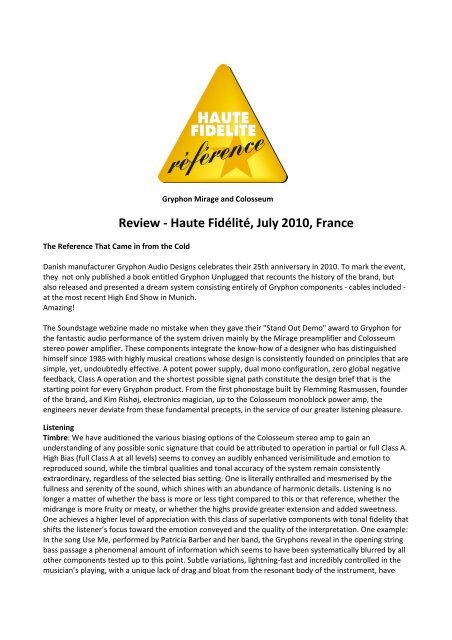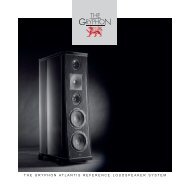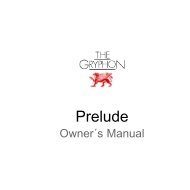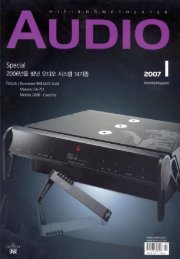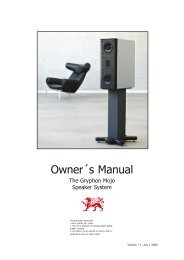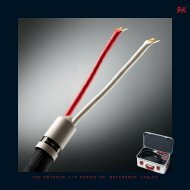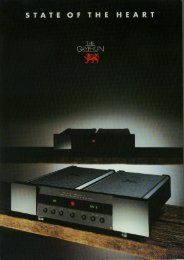Review by Haute Fidélité Products: Mirage & Colosseum Country
Review by Haute Fidélité Products: Mirage & Colosseum Country
Review by Haute Fidélité Products: Mirage & Colosseum Country
Create successful ePaper yourself
Turn your PDF publications into a flip-book with our unique Google optimized e-Paper software.
The Reference That Came in from the Cold<br />
Gryphon <strong>Mirage</strong> and <strong>Colosseum</strong><br />
<strong>Review</strong> ‐ <strong>Haute</strong> <strong>Fidélité</strong>, July 2010, France<br />
Danish manufacturer Gryphon Audio Designs celebrates their 25th anniversary in 2010. To mark the event,<br />
they not only published a book entitled Gryphon Unplugged that recounts the history of the brand, but<br />
also released and presented a dream system consisting entirely of Gryphon components ‐ cables included ‐<br />
at the most recent High End Show in Munich.<br />
Amazing!<br />
The Soundstage webzine made no mistake when they gave their "Stand Out Demo" award to Gryphon for<br />
the fantastic audio performance of the system driven mainly <strong>by</strong> the <strong>Mirage</strong> preamplifier and <strong>Colosseum</strong><br />
stereo power amplifier. These components integrate the know‐how of a designer who has distinguished<br />
himself since 1985 with highly musical creations whose design is consistently founded on principles that are<br />
simple, yet, undoubtedly effective. A potent power supply, dual mono configuration, zero global negative<br />
feedback, Class A operation and the shortest possible signal path constitute the design brief that is the<br />
starting point for every Gryphon product. From the first phonostage built <strong>by</strong> Flemming Rasmussen, founder<br />
of the brand, and Kim Rishøj, electronics magician, up to the <strong>Colosseum</strong> monoblock power amp, the<br />
engineers never deviate from these fundamental precepts, in the service of our greater listening pleasure.<br />
Listening<br />
Timbre: We have auditioned the various biasing options of the <strong>Colosseum</strong> stereo amp to gain an<br />
understanding of any possible sonic signature that could be attributed to operation in partial or full Class A.<br />
High Bias (full Class A at all levels) seems to convey an audibly enhanced verisimilitude and emotion to<br />
reproduced sound, while the timbral qualities and tonal accuracy of the system remain consistently<br />
extraordinary, regardless of the selected bias setting. One is literally enthralled and mesmerised <strong>by</strong> the<br />
fullness and serenity of the sound, which shines with an abundance of harmonic details. Listening is no<br />
longer a matter of whether the bass is more or less tight compared to this or that reference, whether the<br />
midrange is more fruity or meaty, or whether the highs provide greater extension and added sweetness.<br />
One achieves a higher level of appreciation with this class of superlative components with tonal fidelity that<br />
shifts the listener’s focus toward the emotion conveyed and the quality of the interpretation. One example:<br />
In the song Use Me, performed <strong>by</strong> Patricia Barber and her band, the Gryphons reveal in the opening string<br />
bass passage a phenomenal amount of information which seems to have been systematically blurred <strong>by</strong> all<br />
other components tested up to this point. Subtle variations, lightning‐fast and incredibly controlled in the<br />
musician’s playing, with a unique lack of drag and bloat from the resonant body of the instrument, have
never been so clearly perceived. Consequently, they emphasise the intensity of the performance. Shifts in<br />
tonal register as the bassist thumbs the strings of the instrument, are incredibly precise and laden with<br />
micro‐detail. The realism is at its peak.<br />
Dynamics: The specifications provided <strong>by</strong> the manufacturer and the technical details of the amplifier in<br />
terms of power supply filtering and available instantaneous current are dizzying, as is the theoretical<br />
performance of the preamplifier in terms of gain and bandwidth. Therefore, we expected a constant<br />
dynamic emphasis imparting some exaggerated brilliance and demonstrativeness. But what we<br />
experienced was simply quite the opposite. The Gryphons are significantly ahead of the competition with<br />
regard to the precision with which they provide the required amount of instantaneous energy on demand.<br />
Certainly, when it comes to sending Watts to drive transients (bass drum kicks or powerful piano passages),<br />
the listener is well served. Output levels do not suffer from saturation effects or from compression – It<br />
pushes when it is supposed to push. And the timing between the ultra‐fast attack of notes, the amply<br />
documented wealth of detail and the decay that is never muzzled or softened completes the credible sonic<br />
illusion. In the same spirit, during the subtlest pianissimo passages, the Gryphons scrutinize the audio signal<br />
in depth in order to extract the slightest inflection, the most inaudible of micro‐details and the most distant<br />
ambience of the recording space. Thanks to their fully optimised circuits, all steps are taken to preserve the<br />
texture of the musical content. All this contributes to the impression of an analytical precision that is<br />
subjectively superior, with abiding, majestic handling of any style of music.<br />
Soundstage: The analytical capabilities of these Danish components are stunning, demanding a comparable<br />
level of performance and neutrality from the remaining links in the audio chain. Under these conditions and<br />
after optimisation of the system (cables, placement in the room), the soundstage surpasses what one has<br />
become accustomed to. It presents itself as a remarkable spaciousness, a refreshing airiness and a sonic<br />
solidity with a fullness that could be taken for Blu‐ray audio. The foundation established <strong>by</strong> the sublime,<br />
supremely well‐articulated deep bass provides a sense of an unswervingly stable stereo image, laid out<br />
generously and unconstrained before the listener. The wealth of reproduced detail creates an astounding<br />
spatial illusion. One has the feeling that the virtual dimensions of the recorded space have been<br />
augmented, notably in the depth dimension, an area in which most components seem to be<br />
uncomfortable. The layering of elements in Samedi soir sur la Terre <strong>by</strong> Francis Cabrel is extremely precise. It<br />
is as if you can distinguish the position of each music stand in the recording studio, more spacious than one<br />
is accustomed to. The choir singing the score of Dies Irae (Mozart’s Requiem) has simultaneously gained in<br />
level and in physical volume; the singers are spread out across a larger area.<br />
Transparency: The criterion of transparency takes on new meaning with components like the <strong>Mirage</strong><br />
preamp and <strong>Colosseum</strong> stereo amp. Once again, they express themselves fully in a system when partnered<br />
with of products of equal quality. There is not a lot to add that hasn’t already been mentioned in the<br />
preceding listening notes. They are capable of handling all musical genres with alacrity of execution, lasting<br />
clarity and total neutrality. The designer has not skimped and every area benefits. The Gryphons appear to<br />
redefine such terms as “articulation” and “punch” in the deep bass and extreme bass to such an extent that<br />
they have rarely been reproduced with such tonality and immediacy. The general timbral quality in terms of<br />
the accuracy of tonal reproduction scales new heights, each recording rendered with its own specific range<br />
of colours. The great subtlety of the highs combines with agility, acuity and body rarely found<br />
simultaneously in transistor components at any level.<br />
Conclusion<br />
As usual, the Danish designer has not skimped on the concept and build quality of the two electronic jewels<br />
dubbed the <strong>Mirage</strong> preamplifier and <strong>Colosseum</strong> power amplifier. Frankly, we had been quite taken with the<br />
sonic performance of their integrated Diablo. It appears that the envelope has been pushed much further<br />
back with the <strong>Mirage</strong>/<strong>Colosseum</strong> pairing, which deserves to be regarded as a sonic reference that will go
down in the history of high fidelity. The exclusive build and pedigree of each component are combined with<br />
perfectly optimised technical solutions mastered <strong>by</strong> the makers. The breathtaking performance manifests<br />
itself to the listener as a neutral rendering, subtle and captivating, yet capable of expanding from a whisper<br />
to a blast of notes at the slightest prompting. The radical cosmetic aesthetics add a touch of elite distinction<br />
essential in products of total sonic transparency. Stunning.<br />
Build: 5/5<br />
Timbre: 5/5<br />
Dynamics: 5/5<br />
Imaging: 5/5<br />
Transparency: 5/5<br />
Quality/Price: Irrelevant<br />
New magazine Reference


